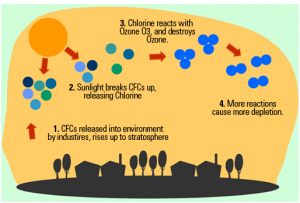What Is The Ozone Layer?
The ozone layer refers to a region of Earth’s stratosphere which absorbs most of the Sun’s UV radiation. It contains high concentrations of ozone (O3) as compared to the other levels of the atmosphere, however, the concentration is still relatively small compared to other gases in the stratosphere. The ozone layer contains fewer than ten parts per million of ozone, whereas the average ozone concentration in Earth’s atmosphere as a whole is only about 0.3 parts per million. The ozone layer is mainly found in the lower portion of the stratosphere, approximately 20 to 30 kilometres above the earth surface. Factors such as the season and geographical location affects the thickness of the ozone layer.
The ozone layer absorbs 97–99% of the Sun‘s medium-frequency ultraviolet light which has a wavelength of about 200 nm to 315 nm, stopping potential damage to exposed life forms near the surface.
Chemical Process
Ozone in the Earth’s stratosphere is created through two processes. Firstly, when ultraviolet light strikes oxygen molecules containing two oxygen atoms (O2), it splits them into individual oxygen atoms (atomic oxygen)
O2 + ℎνuv → 2O
The atomic oxygen then combines with unbroken O2 to create ozone, O3. However, the ozone created is chemically unstable and when ultraviolet lights strikes it, it splits into a molecule of O2 and an atom of atomic oxygen. This results in a continuing process known as the ozone-oxygen cycle.
O + O2 ↔ O3
Ozone Depletion
There are many various causes of ozone depletion.
But the largest cause would due to the reaction of ozone with free radicals such as nitric oxide (NO), nitrous oxide (N2O), hydroxyl (OH), chlorine (Cl), and bromine (Br). While most of them can be found naturally, the concentrations of chlorine, and bromine have increased significantly in recent years due to the release of large quantities of man-made organohalogen compounds, especially chlorofluorocarbons (CFCs) and bromofluorocarbons. These highly stable compounds are capable of surviving the rise to the stratosphere, where the radicals are liberated by the action of ultraviolet light. Each radical is then free to initiate and catalyze a chain reaction capable of breaking down over 100,000 ozone molecules. This results in a reduced capability of the ozone layer to absorb the ultraviolet radiation.
Other causes of ozone depletion can be natural such as large volcanic eruptions which can have an indirect effect on ozone levels. When volcanoes erupt, they produce massive clouds of ashes into the troposphere, and then they drift upward into the stratosphere. These ashes contain high concentration of bromine and chlorine. Ashes can stay in the stratosphere for about two to five years, and causing chemical reactions that can damage the ozone layer withn this period of time.
Effect of Ozone Depletion
Ozone depletion results in the amount of UV light reaching the earth surface to increase which has a varied impact on the various living things on earth. For example, in the case of humans, this leads to a rise in getting skin cancer and possibly cataracts — a clouding of the eye’s lens. As for plants, UV light results in various changes in the growth mechanisms of the plant, some possibly more beneficial than damaging. Other affected parties include the marine ecosystem, biogeochemical cycles, materials and et cetera.

